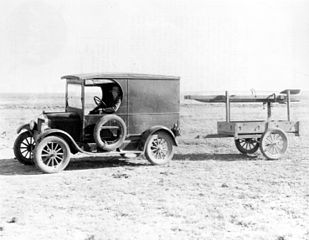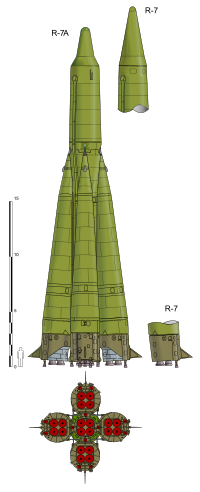I understand it, but I don't think it's justified. Some people give too much credit to the Third Reich for developing rockets. Rockets were around since at least
Marco Polo's time. The Chinese had gunpowder and made rockets with it as well as other weapons. Thus they created the solid fuel rocket. The the
V-2 was developed under the Third Reich, and it was not a solid fuel rocket. Let's look at who first developed the liquid fuel rocket and then let's look at rockets after the V-2.
 |
| R.H. Goddard towing a rocket |
In 1923 a man who had been a sickly child and a book-worm, tested a gasoline and liquid oxygen rocket engine. For years before, he had experimented with solid fuel rockets. He had made guidance systems, and mathematical formulas to predict trajectories. In 1926 this man made the first liquid fuel rocket launch from a farm in Auburn, Massachusetts, USA. It went to a height of 184 feet in 2.5 seconds (
Wiki). That man was Robert H. Goddard. Yes, the liquid fuel rocket was invented in the United States, not Germany. Regardless, even Goddard thought of space travel with rockets and made experiments to that end (
Wiki).
 |
| V-2 replica |
|
Since Goddard there were several rocket enthusiasts around the world working where Goddard left off. They followed Goddard's writings. One group in Germany included
Wernher Von Braun, who had a really long name. He made rockets for the Third Reich, namely the V-2 rocket. What the Third Reich provided was resources and enthusiasm for the rockets. They were used as an instrument of war, but even Von Braun dreamed of space.
 |
| R-7 | |
At the end of World War II, the Soviet Union (USSR) and the United States (US) grabbed as much as Germany as they could including rocket scientists and V-2 rockets. The USSR made the
R-7 as the first ballistic missile that could launch and atomic bomb. While Von Braun was the mastermind behind the Saturn rockets,
Sergei Korolev was the mastermind behind the R-7, the
Vostok, the
Voskhod, and N-1 rockets. Following the same pattern, Korolev was part of a rocket society before World War II and was a rocket engineer. He was imprisoned for 10 years in the USSR. He was released to work on the rockets. He was also instrumental in convincing Khrushchev to launch a radio transmitting satellite instead of making a weapon demonstration with the rocket. Thus Sputnik-1 was launched and the world would never be the same again. You see, Sputnik-1 was the first satellite as we understand man-made satellites today. It transmitted a 'beep' that could be picked up by any ham radio enthusiast. People in the US feared USSR from then on.
Of course we know that the US gave USSR chase in the space race which resulted in the race to the Moon. Von Braun and his team made the
Saturn IB and
Saturn V rockets under NASA. Saturn V still remains the most powerful rocket ever flown. It's the epitomical rocket of the space race and the race to the Moon. It could take 260,000 pounds to orbit. Impressive by any measure. The N-1 was also impressive but not quite as the Saturn V. It could take 200,000 pounds to orbit.
 |
| SkyLab riding on a Saturn V |
When the space race was done, the big rockets were not as much needed anymore. One Saturn V launch was done to put the first US space station called
SkyLab into orbit. USSR also followed the space station approach to space research. The cold war ruled. Rocketry became subordinate to
Inter-Continental Ballistic Missile (ICBM) build up. Which took the whole of society to the brink of annihilation. The flip side of rocketry was the satellite industry, both military and commercial. Today the Russia and the US uses a variety of rockets and a variety of sizes to launch all kinds of satellites.
 |
| Long March 3B |
Today we have dedicated rockets for satellites and unmanned spacecraft.
Boeing Delta IV,
Delta IV Heavy,
Atlas V, and
Falcon 9 are among the biggest rockets in the US. Russia has the
Soyuz and
Proton rockets as their biggest. Europe has the
Ariane V, Japan has the
H-IIA and China has the
Long March 3B. India also has a rocket called the
GSLV which can lift 11,020 lbs to orbit. Interesting to note that India is developing a heavier vehicle called the
GSLV-III that will rival Falcon 9 as far as lifting capability to orbit. It's maiden flight should be soon. These rockets can lift from around 15,000 lbs to 50,000 lbs to orbit. If you consider that today's
shipping containers can weigh up to 68,000 lbs, you see that these rockets fall short of commercial shipping standards as far as capability. Almost all these countries are developing bigger rockets. If humans are to expand their living quarters to space, the moon, and mars, they have to have bigger rockets and fly them cheaper than they do now. This is the big drive. There is a future in rocketry.
We looked at Goddard and his rockets, then looked at the cold war rockets of the US and USSR, and finally we looked at the modern rockets. It's really amazing that most of the technology that was essential to rocketry was developed by one man, Robert Goddard. To get from Goddard to today's rockets, there were myriads of men and women developing technologies to go bigger, faster, and farther. These people were of all kinds of backgrounds including different political backgrounds. The rocket is a tool for man. Let's hope we can use it wisely.





